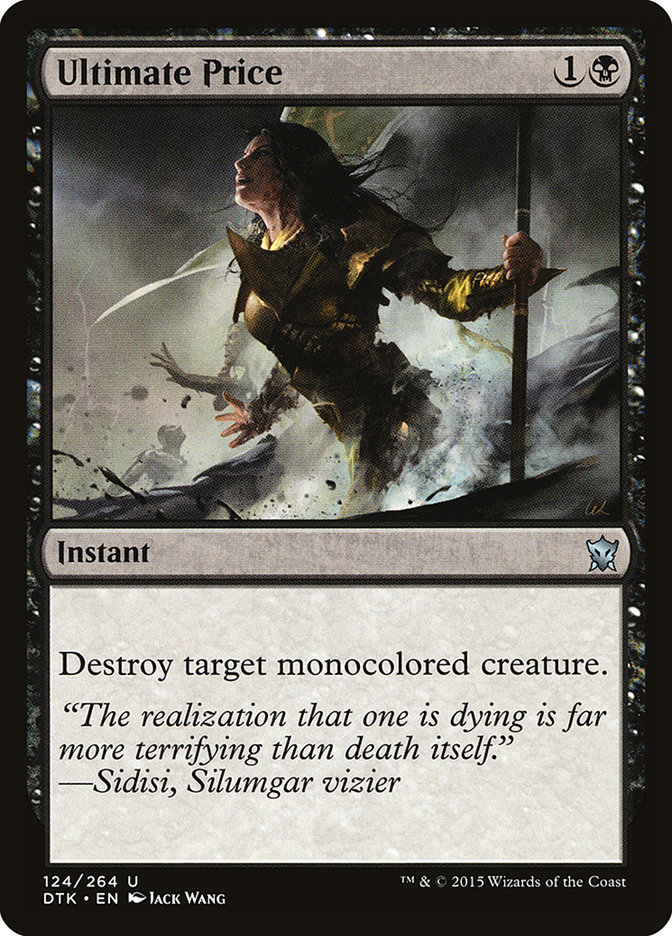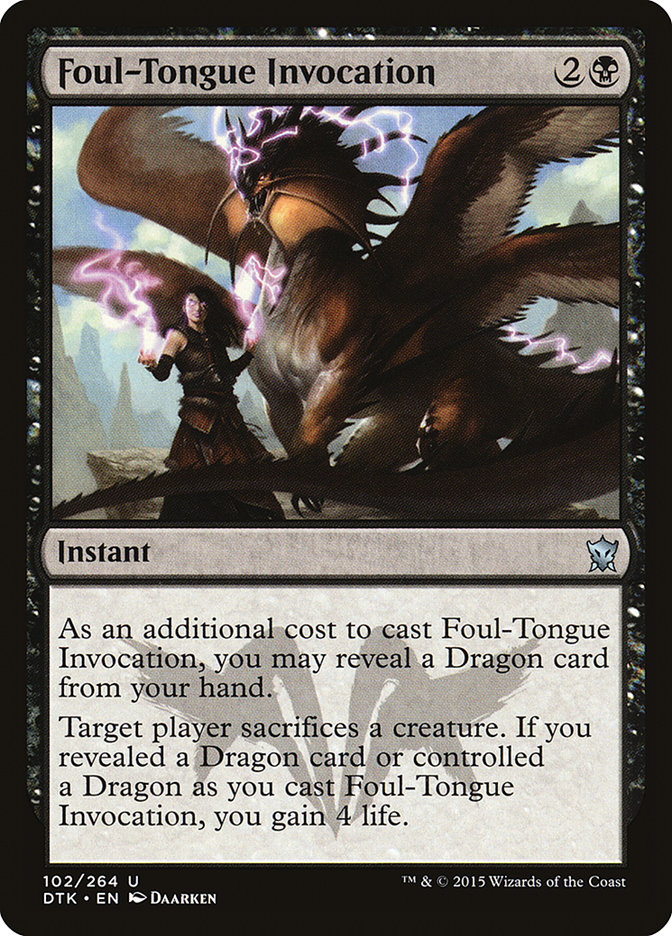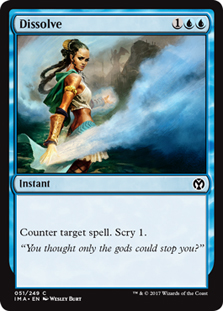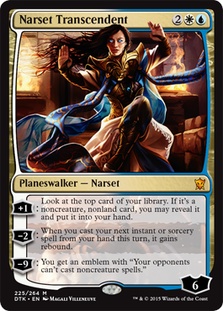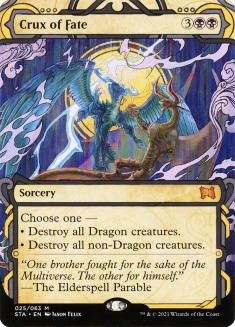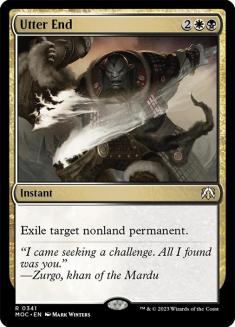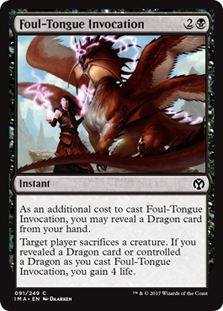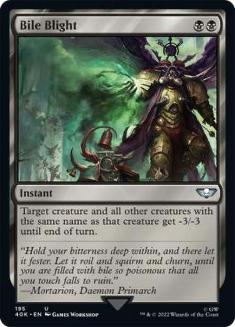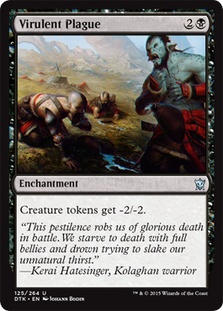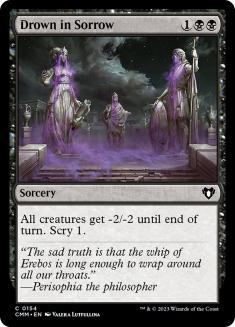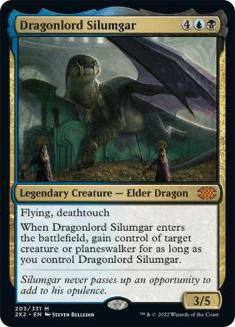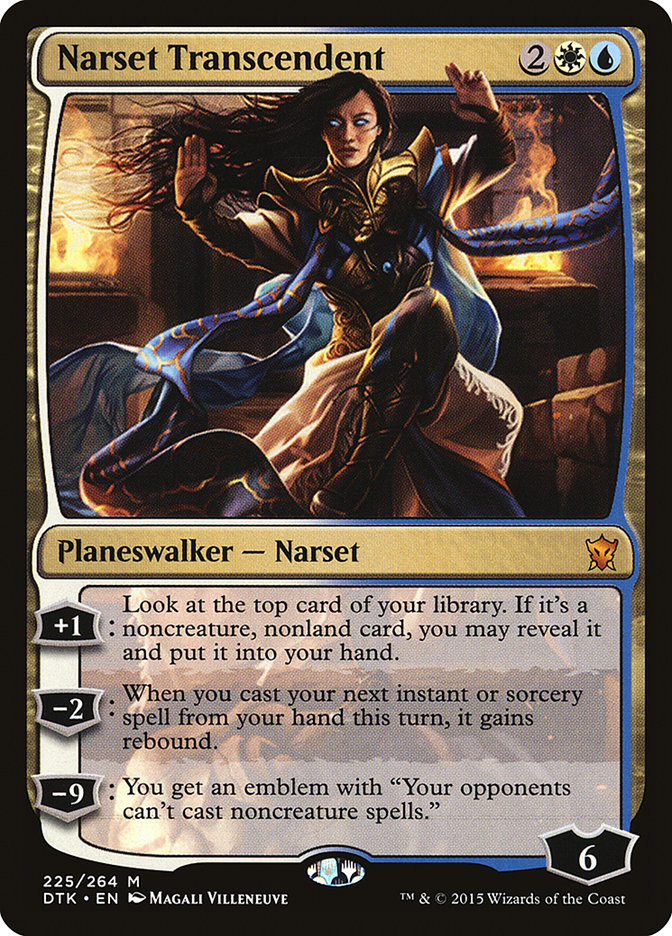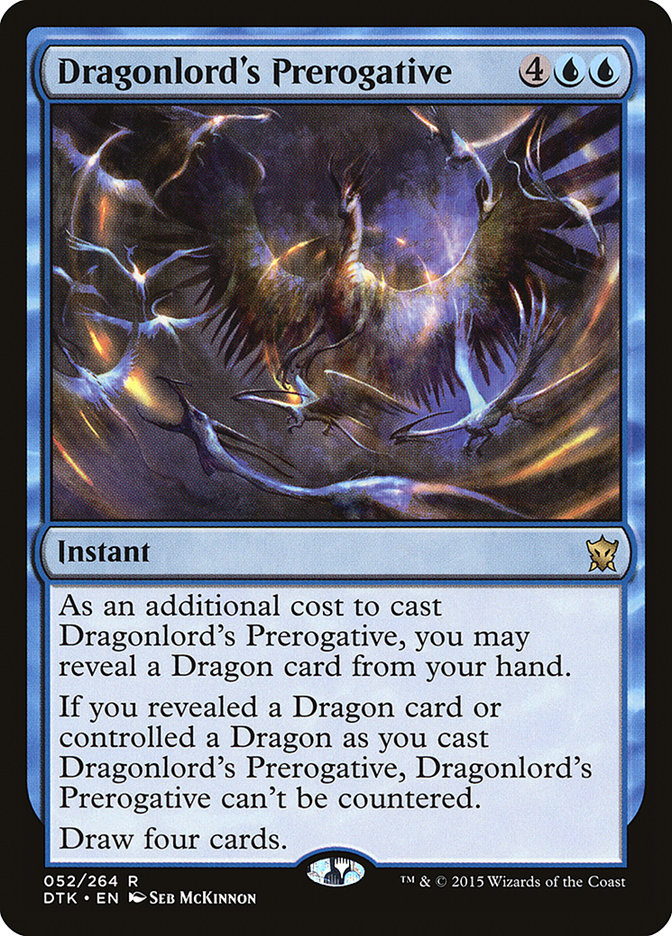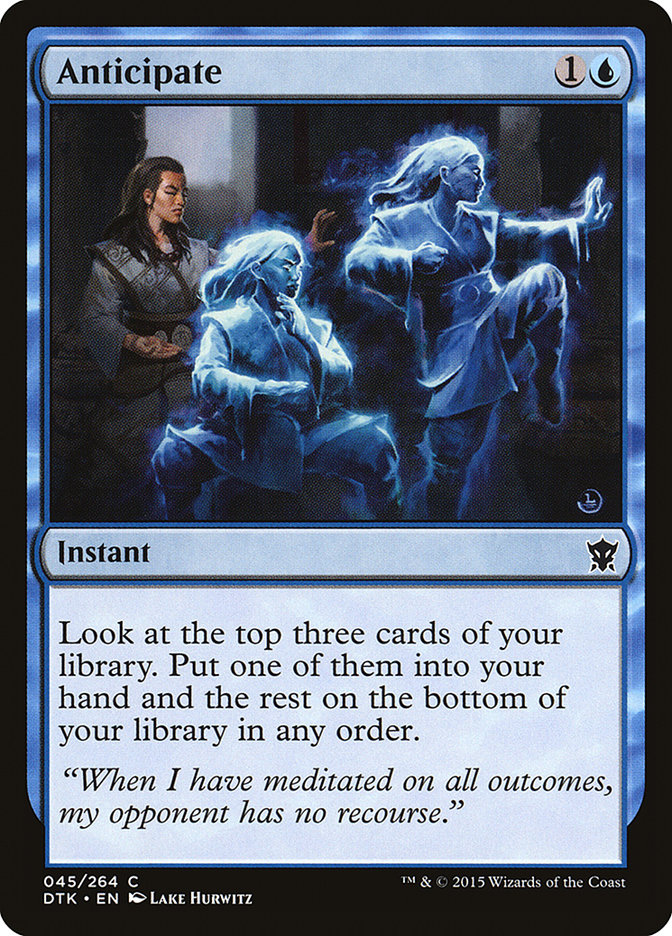Do you hear that?
That is the beautiful sound of the control revival in full swing. For far too long creatures have held us down, waves of aggressive strategies put us on
the endangered archetype list, but that time is over. The last time we spoke, I
gave a rallying cry for those who wish to take the control plunge side by side with me. Today I’m reporting back with a Season One Invitational result of
12th place under my belt, as well as endless matches played on Magic Online with the most updated list you can find. There are certain cards that shined
and some that underperformed, which was to be expected from any new list on its first official test run, but the truth of the matter is that live play and
online play have very different metagames. It seems that anyone that can scrounge up $23.43 for Mono-Red Aggro and charge right into battle online, where
in real life you’re more likely to see green decks every other round. I’ve taken that into consideration prior to giving you all a decklist because I want
to present the best possible 75,
I’ve mentioned on multiple occasions that I practice what I preach, and I always play the lists I write about because I truly believe in them. For years
I’ve believed in U/B Control or Esper Control, and that is why I ran them until rotation, but this Esper is different. The power level of the spells that
I’ve had the pleasure of battling with clearly dominates those of the past-with the admitted exception of Sphinx’s Revelation. That version of Esper
Control had a dominating card advantage spell with an unkillable win condition, but that isn’t what makes control great. Control is great when it wins, and
in the current metagame, that is exactly what it does. I’ve played endless eight-player tournaments online, racking up an absurd win rate, and my only
losses have been to Temur Aggro and Mono-Red Aggro. These are acceptable losses, especially when my matchup against Mon-Red has officially hit 50/50 with
the new changes. I would make the matchup even better with additional Foul-Tongue Invocations and a removal overhaul, but I want to ensure victory over a
multitude of decks and not just one. Burn strategies are always more popular online due to their low price tag, easy to master lines of play, and general
effectiveness against slower decks. Luckily for us, the matchup isn’t a lost cause, and I’ll be sure to give you all the secret code to victory.
Now let’s talk about the polished version of Esper and highlight the changes with my thought process behind each one.
Creatures (4)
Planeswalkers (2)
Lands (26)
Spells (28)

Let’s start out by talking about the most controversial selection in this season’s Esper Control. I am honestly baffled by the doubt surrounding Ultimate
Price, and I still firmly believe either people haven’t played enough matches with the deck, or they are running up against Abzan Aggro and always losing
the die roll. Ultimate Price was the best card printed for the deck besides Silumgar’s Scorn and the Dragon package. This two-mana removal spell has the
perfect color requirement to ensure that a Silumgar’s Scorn is also a possibility, maybe even an Anticipate if your opening contains it. Leading off with a
Temple of Deceit is the dream play because of the six untapped Islands Esper has to follow up with. Bile Blight very well may be a better removal spell
against some of the decks, but Ultimate Price is better against a much wider range of threats. I’ve written a couple articles that may have explained the
Ultimate Price role in Esper Control to some extent, but today we are going to break it down.
Being easier to cast is no joke for a three-color deck. Needing double black on turn 3 for Hero’s Downfall or Drown in Sorrow is ridiculously easier to
obtain than on turn 2. With eight Temples, you will probably be able to cast a Hero’s Downfall at the same time as Bile Blight, which makes the spell far
less effective. This isn’t U/B Control, and since we are depending on more tapped lands to produce the appropriate colors, we have to make sacrifices. I do
not think Bile Blight is a bad card, and I’ve actually included them in the sideboard to help target the Abzan Aggro matchup when we have to sideboard out
Ultimate Price due to lack of targets. That said, there isn’t another matchup on the planet where I sideboard out Ultimate Price in favor of Bile Blight.
Even the token decks have must kill creatures such as Soulfire Grand Master, Goblin Rabblemaster, and Seeker of the Way. Many of these decks that utilize
these cheap white and red creatures also have Stormbreath Dragon. Using the full four-of Ultimate Prices with a couple Bile Blight will strike fear in the
heart of any aggressive player, but that will only be applied for the sideboarded games. The spells in the maindeck of any control deck must be chosen
according to their castability, which is why you don’t see any Elspeth, Sun’s Champion in a Shaheen Soorani control deck.
Ultimate Price kills everything that a two-mana spell can kill outside of the Abzan Aggro decks. It kills every red and white threat, all the blue and
green early drops from Temur, any copies of Courser of Kruphix that are running rampant, Stormbreath Dragons and younger brother Thunderbreak Regent, the
scariest green creature (you know it as Whisperwood Elemental), and it even kills Warden of the First Tree, not to mention those pesky vampire tokens from
Sorin, Solemn Visitor out of the Abzan Aggro deck. I know the last examples are a stretch, but it’s evidence that they aren’t completely dead in the
matchup. With all of the scrying that we utilize and the power of countermagic against Abzan decks on the play, we can afford to have a density of weak
cards in the first game. I rarely, if ever, lose to Abzan Aggro when I win the die roll. If you lose the die roll, then you have to take a beating until
they pass the turn without a counterspell needed to be dispatched (so you can remove their resolved threat), or cast a Crux of Fate to get right back in
the game. There are so many different decks you can play against over the course of a tournament. You may play against Fleecemane Lion twice, and all of
that stress you had was for nothing. You scryed an Ultimate Price to the bottom, cast an array of powerful spells, and easily dominate your opponent game
1. The matchup against Abzan Aggro after sideboard is so good that you’re licking your chops with two more games left to play, knowing you’ll take down the
match. This is the reality of the matchup my friends…trust me.
Ultimate Price and Bile Blight are pretty crappy against the same decks with some exceptions. These cards are horrendous against the control mirror, but at
least Ultimate Price can fog a Pearl Lake Ancient a few turns in order to achieve victory. Outside of that scenario, these cards are ineffective and don’t
exist in the deck after game 1. When playing against Abzan Midrange or Abzan Control, however, Ultimate Price really shines in comparison. The slower Abzan
decks pack Tasigur, the Golden Fang, Sidisi, Undead Vizier, and of course, Courser of Kruphix. These cards laugh at Bile Blight, but they are answered by
Ultimate Price with ease. There are so many other cards that may pop up in these slower decks that can be targeted by Ultimate Price but will never be able
to be answered by Bile Blight. Keep that in mind when weighing the pros and cons of the removal package you select. Going back to my first point, if you do
decide on Bile Blight and ignore the wisdom I present, then you’ll need to revamp the manabase with a complete Temple overhaul. Dismal Backwater will have
to replace some of the Temples and more Caves of Koilos would substitute in for Temple of Silence.
This spell was in my first draft of Esper Control and was removed right before the Season One Invitational. I was afraid that too many Elvish Mystics and
Sylvan Caryatids would interfere with the effectiveness of the removal spell. That was true for the most part, but the four life gained off of the spell
has made it the best card against aggro there is. Even though red can overwhelm with creatures, Foul-Tongue Invocation brings you right back in after a
successful board sweep. The 50/50 matchup I boast about when playing against Mono-Red is obtained by a Drown in Sorrow, followed by a Foul-Tongue
Invocation. Due to the importance of the lifegain, I bring in Dragonlord Silumgar to maximize my chances of having a Dragon. The 3/5 body on the flyer
isn’t bad either, allowing me to take a threatening critter off of the battlefield and block another.
Here’s how I sideboard against them:
Out:
In:
After sideboard, the matchup is in our favor, but it is still scary because we are almost certainly down game 1. This is the best chance we have to beat
Mono-Red without butchering the rest of our deck, and it heavily relies on the lifegain of Foul-Tongue Invocation and the superior sweeper in Drown in
Sorrow.
Foul-Tongue Invocation is fantastic against Abzan Aggro as well. They rarely have multiple creatures out against control, and when they do, we are happy
with any of them hitting the graveyard. It answers Rakshasa Deathdealer without having to worry about regeneration, Fleecemane Lions that have gone
monstrous, and any other threat they can muster. The lifegain allows us to bounce back from taking a few hits from these monsters, and at instant speed,
it’s a bargain. These edict effects, the two Bile Blight, and four Silumgar’s Scorn allow us to even the playing field games 2 and 3 after a possible loss
from too many Ultimate Prices game 1.
Foul-Tongue Invocation is oddly amazing against the control mirror as well. Almost all control decks have turned to Dragons, which all fall to Foul-Tongue
Invocation. I sideboard in one additional copy usually, and that has worked wonders for me so far. Use this removal spell at your own discretion. I
sideboard it in when edicts aren’t very good for the sole purpose of gaining life later in the game. There isn’t a matchup where I take all of them out
except against a deck that we are sure has only tokens in it. Most token strategies still try to burn you out and have some copies of creatures that find
themselves alone on the battlefield.
Slight Changes in Numbers
You probably noticed the number of Narset Transcendent went from three to two in the maindeck. This is due to the 30 some odd aggro decks in the top 32 of
the Syracuse Standard Open, as well as the massive G/R Aggro insurgence on Magic Online. I can imagine that the amount of Abzan Midrange, U/B Control, and
Esper Control decks in your metagame have also declined, which leads us to drop our powerhouse Planeswalker to two copies. You still want three of them in
your 75 for sure, and for that reason, the additional copy is in the sideboard ready to be summoned to battle. Narset Transcendent is easily one of the
best Planeswalkers control has ever had, but even Jace, the Mind Sculptor would get mauled by an opponent with four one-drops before he had a chance to
resolve.
I made some pretty ambitious comments in both my deck tech at the Season One Invitational and on social media, comparing the iconic planeswalker to our
current day option of Narset Transcendent. Jace, the Mind Sculptor will always be the best planeswalker of all time, however, in his first appearance it
was just an unsafe world. Bloodbraid Elf, Maelstrom Pulse, Blightning, Lightning Bolt, and Valakut, the Molten Pinnacle existed to hate on the legendary
Planeswalker. Don’t get me wrong friends: I bought four of them at twenty bucks a piece and went on a brief interview at an old SCG event where I said he
was criminally cheap and needed to be purchased, but it didn’t make an impact until those juggernauts rotated out of the format. Narset Transcendent has
the feel of a Jace, the Mind Sculptor in Standard for me. On an empty board, or a board with one threat, it can produce card advantage, and then untap and
do horrible things to an opponent. On camera against Jim Davis, I cast Dig Through Time six times in one game. I didn’t have to fateseal to get out of burn
range, but instead, I just abused my opponent’s lack of black mana with countless rebound spells, which included an Utter End to take out two Outpost
Sieges. Is Narset Transcendent better than Jace, the Mind Sculptor? Absolutely not, but in their first respective Standards, one survives and makes a much
bigger impact in the control shell. I’m sure this will receive a little bit of flack, but I love you guys, and I know you’ll go easy on me!
The other changes included a Dragonlord’s Prerogative and moving to two copies of Anticipate. The additional card draw spell is to assist us in the control
mirror and make up for not having Thoughtseize ourselves. Thoughtseize I wrote about in great detail before, and there is simply no room in the deck for
one of my favorite control cards. The big point I was driving home with Thoughtseize was how bad it was when drawn late, but now the deck is sculpted in a
way where dead draws just don’t occur like that. Dragonlord’s Prerogative acts as a dominating card draw spell that can be used against any blue deck or
any deck that uses Thoughtseize to strip us of our Dig Through Times.
I was pretty down on Anticipate in Esper control, but I was ecstatic about it in U/B Control. The existence of twelve Temples allows us to pass on
Anticipate because the scry sculpts our draw and allows us to hit lands on time well enough. I think Anticipate is still a great card and will always exist
in the deck in some capacity, but the dream of having two open with Anticipate and Silumgar’s Scorn as an option with all of these enters the battlefield
tapped lands is a bit farfetched. The reality is that we aren’t using the card draw spell until later in the game, and it would have been better as another
answer to help us survive rather than selection to help us filter. If you are in love with Anticipate, then by all means, up the count, but it’s
unnecessary with all of the scry from Temples and Dissolve.
Esper is real right now, and I hope that this build, or another you come up with, will help lead you to victory at Spring States this weekend!


